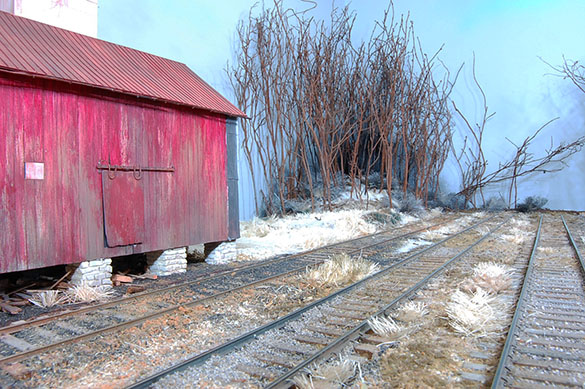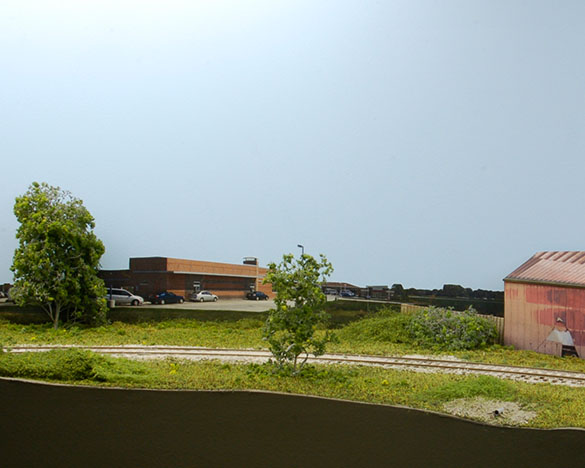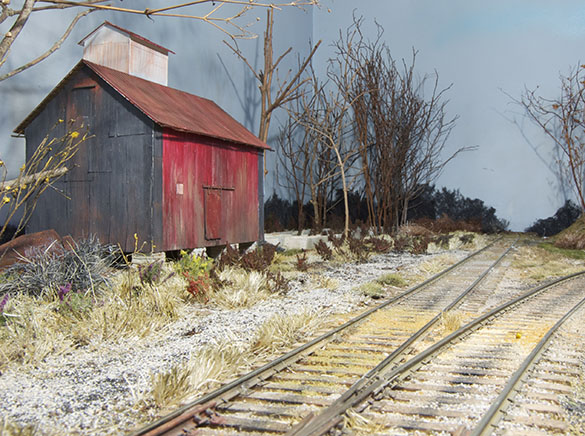What shade of blue should I paint my backdrop? What’s the best scale to work in? What kind of track should I use and what’s the best kind? How many freight cars should I get? How high should I make my benchwork?
When I read questions like these, I just shake my head at how far down the road to mediocrity things have gone. The answers to these kinds of questions boil down to personal preference, but in the quest for quick and easy solutions to everything, people are no longer willing to think on their own or simply try something and learn from the process. It’s sad.
Without a solid base of skills and deep knowledge, the craft of railroad modeling will wither away from indifference. I view building this foundation as an investment in the future and to that end, I publish The Missing Conversation to help you ask and answer your own questions about our craft.
August 1, 2013 marked its one-year anniversary and I’m satisfied the concept of a single topic serialized publication is valid and I have themes outlined that will take it well into 2014. Each volume is designed to stand separately but there is a larger story arc running through them with an emphasis on learning, rather than being told what to do and how.
It’s a partnership
Readers and authors are the lifeblood of any publication and as planned from the start, recent volumes included guest articles and interviews. For now, I’m only commissioning articles from modelers I believe are pushing our craft forward. I believe readers deserve no less. I invest in authors by giving them a chance to share their work without the straightjacket of an advertiser driven editorial policy.
I made a firm choice therefore, not to include outside ads, even though publishers everywhere depend on ad revenue to cover production costs. Am I a fool? According to some, most likely, but I want to be accountable to the readers first and foremost, not advertisers’ purse strings. I want the freedom to say what needs saying without the worry of a major sponsor bailing out as a result.
The economics of digital publishing make a one-person micropublishing house like mine possible. That said, all future works will be digital first. Doing this on paper simply isn’t feasible because the numbers don’t work. It could be done, but the cover price would be ridiculous and circulation would need to be much broader. I may do a print on demand version of a specific title if there is enough interest but my costs will be considerably higher going this route, so be prepared for a much higher cover price than usual.
This might not work
There was a critic who generously shared that I was committing suicide by charging for a digital magazine. Thank you dear readers for proving him wrong. You’ve graciously supported this work and I’m very appreciative of that. It tells me that you value the material and approach. Vol. 06 is on the way. Here’s a preview.

Volume 06 shares how I turned a mundane scene like this one into one that tells a more compelling story.

Also, James McNab shares how he adds depth to the scenes on his Iowa Interstate Grimes Industrial Line shelf layout via photo backdrops. Photo by James McNab.
Regards,
Mike

Well, this reader would like to offer his thanks in public. You have provoked me to question very deeply where my modelling was headed, and it has headed in a different direction – in terms of prototype – but has become more firmly anchored than before – in terms of scale and standards. Yes, everyone must set their own standards, and if they are happy with the results, then that’s fine, but that does not mean I have to like it (or call it a “model railway” if it is little more than a nicely arranged toy), encourage mediocrity or refrain from making critical and constructive comments.
It is also nice to see others’ comments on here, supporting your desire to encourage modellers to think for themselves, and have a go.
Mediocrity will always be with us: it is the average, and by its very nature there will be one, with half below it and half above it*, but there is no reason to praise it, to decry the pursuit of excellence (so long as it brings happiness) or to aim for it (unless well below it!)
Simon
*Mathematical literacy is so poor in this country, that a Member of Parliament recently asked why “half of our school children have below-average achievements”.
Thank you Simon. Well said as always.
Regards,
Mike
Unfortunately, not an easy answer to mediocrity. However if I may, I rather think that the modern world and the ready access to all sorts of public and free information are culprits of the first order. Now I am not suggesting that blogs, websites etcetera are to blame, its the reader who has lost the ability to discern the relationship between what is quality and what is here-say or just codswallop.
If you look at statistics for the level of concentration humans allocate to a task it may frighten you.
http://www.telegraph.co.uk/health/healthnews/3522781/Stress-of-modern-life-cuts-attention-spans-to-five-minutes.html
Interestingly enough, if you read as far as the fifth short paragraph of that article, salvation for us in our later years shows an interesting fact. Could this be simply that we old school modellers, who enjoy the craft and discipline, devoting our time to a pursuit of excellence and self fulfilment by achieving a level of pride and satisfaction from our hobby. I would resonantly say yes… It removes us from the frivolity and social disengagement of all the modern devices we use to communicate to one another (with the exception of this obvious interaction, but you get my idea).
Rather than get involved by practical means, it is easier to just ask a question on the web… how high should my benchwork be? How many boxcars should I buy? The obvious reaction is to skim through articles that are short (remembering that I will probably only use less than my five minutes attention span) to wade through a plethora of rubbish before I get the answer I want, rather than the question I should be asking correctly – thereby, further aiding and abetting mediocrity.
If however, you take the time to read an article from this site that has a lengthy and rich discussion on such matters, causing some cognitive thought process, you will never get to ask the right question. Concentration dwindles and the upshot is, so will your hobby and modelling efforts. Quid pro quo.
If you make no effort… how can you ever be rewarded with the fruits of your labour?
Cheers,
Marz
I notice at work that younger employees are inclined to come in, do the work that is set before them, and go home. Opportunities to take the initiative abound, yet are rarely taken – if it is not written down, or part of the established routine, then new things will only be attempted if there is some training provided – even management.
And do you know what? That’s what we do.
For everything.
I am not against providing support and encouragement (I would have benefitted from some myself!), and I applaud the desire to strike a good work-life balance – more hobby time – but at the same time, we seem to be taking away the opportunity and desire to think independently, to ask oneself questions, to set new challenges. In my experience, thinking is like using muscles: if not used, atrophy sets in. I think this spills over into the hobby, too.
I don’t foresee the death of the hobby, by the way: the ready-to-play market has some very high quality toys for the operationally inclined. I do see the craftsman side of things remaining pretty static, though. I don’t think there are fewer skilled craftsmen in the hobby than before, but they produce fewer models due to more calls on their time – often enjoyable ones, such as attending opera, theatre, etc. I also think that rather than being seen as the inspirational figures they once were, they are increasingly dismissed as “rivet counters”. Even those who strive to have fewer models of higher quality will down-play this as such. I suppose that you could say that I see an overall improvement in the models, but the reverse in the modelling, as more people have to do less actual modelling in order to achieve a working model railway. Modelling is seen as assembling a collection and arranging it on a piece (or pieces) of wood or thick foam. Even trying to get that right can be decried as “obsessive” – don’t worry about the correct placement of the correct type of signals, as having a few around the layout adds to the “atmosphere”. Many magazine editors seem unconcerned about this, too, just so long as the major advertisers are kept happy, and articles are presented in a bright, breezy, picture-filled manner that requires minimal thinking.
Simon
.
Marx,
Yes indeed. I’m beginning to understand the connections you’ve mentioned and the repercussions they bring. As the external sources and demands on our attention increase, we tend to feel more overwhelmed by it all. For many this leads to greater levels of passivity, with less and less effort expended. The results become obvious over time.
Regards,
Mike
Simon,
I’ve learned that our cognitive abilities have practical limits before the need to recharge before continuing arises. As Marz suggested, the number of distractions on our focus is greater than ever. This is why I backed out of all forums: they took too much mental energy, that was required for more important things.
As for this whole matter of standards, I view them as a personal line in the sand and as a tool. As a line in the sand, I can say this is what I will tolerate and what I won’t. As a tool, standards supply a benchmark to measure against. I achieved my standard or I didn’t. Further, I have objective feedback on where things fell short. Therefore, I’m building my capacity for future skills and greater enjoyment.
Regards,
Mike
I agree with that – sadly. I say sadly, as they can be a great source of information and a superb way to make friends. Unfortunately, those looking for an argument rather than debate and those keen to make “me too” posts tend to clog things up.
As an aside to that, and to bring this back on topic, my friendship with Geoff Forster, of “Penydd” and “Llangullo” fame,came about via a forum, but because there are too many trolls hiding behind a pretence of “decency”, I sent him a private message rather than making a public post. And the content of that post? Merely a statement that I felt – based on evidence presented – that an item intended for Penhydd wasn’t up to his usual standard (notice that such a statement starts fom a position of respect). This was in marked contrast to the half dozen or so posts of fawning praise which did appear. As it happens, Geoff wasn’t happy with his work, and appreciated my honesty: on such a basis is genuine friendship founded. However, had I said that in open forum, I would have been pilloried: but not by Geoff! (Don’t ask me how I know this!)
Funny old world…
I agree about setting standards as a tool, maybe yardstick would be a good term – that is a genuine 3 foot rule! Either a model is up to the standard you have set, or it is not yet good enough. The only personal variation in this is how high one sets the bar, and whether it is static or moved up with time and experience.
Simon
“The only personal variation in this is how high one sets the bar, and whether it is static or moved up with time and experience.”
Exactly Simon. Exactly.
Regards,
Mike